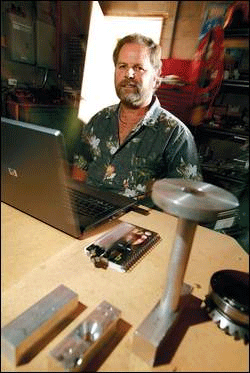Sometimes the simplest ideas are the ones that move society forward the most.
Running a pole between two wheels to make an axle. Running steam through a tube to drive a piston. Building an engine into a cart to make a car.
Working out of his nondescript garage in Redmond, Brad Raether thinks he has found another one of those great leaps forward with a relatively simple innovation, and he's putting all of his time - and a healthy chunk of his own and his family's money - behind it.
In essence, Raether says he has developed a more efficient way to transform linear power - the drive of a piston or the stroke of a bicyclist's leg - into rotary power - the motion needed to drive wheels.
The idea looks simple. Rather than hooking the bottom of a piston rod to a crook in a crankshaft, which is the way piston engines have converted linear motion into rotary motion for 300 years, Raether's model uses a crossbar that runs inside a race in the cylinder wall to twist the piston rod with each stroke. The bottom of the rod spins a gear, which connects directly to a drivetrain, eliminating the crankshaft altogether.
The design of the race gives the piston more leverage throughout its stroke, transferring about three times more of its power than a conventional piston, Raether said.
Among the potential results: Production automobiles that get 75 to 100 miles per gallon, with minimal changes to their standard engines.
Or possibly more efficient bicycles, pedal-powered cars, or small pedal-powered airplanes.
Or possibly more efficient power production plants. More efficient compressed air-driven vehicles, used extensively in mining and manufacturing where sparks can be deadly. And standard internal combustion engines that could run at lower RPMs because they transfer their power more efficiently, dramatically reducing fuel usage, waste-heat and engine wear and tear.
Raether says his tests have shown so far that any of those outcomes are possible with his invention, if he can get it to market.
His patent is pending but, as with most inventions, commercializing it is not an easy task. Read

